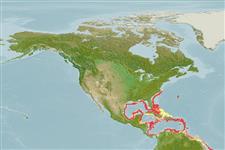>
Anguilliformes (Eels and morays) >
Nettastomatidae (Duckbill eels)
Etymology: Nettenchelys: Greek, netta = duck + Greek, enchelys, -yos = eel (Ref. 45335); pygmaea: Named after the Greek pygmaios meaning small, dwarf, referring to the small size of the adults..
Environment: milieu / climate zone / depth range / distribution range
Écologie
marin bathydémersal; profondeur 128 - 280 m (Ref. 37039). Tropical
Western Central Atlantic: northern Gulf of Mexico and off Venezuela. Probably fairly widely distributed in the western Atlantic (Ref. 40819).
Length at first maturity / Taille / Poids / Âge
Maturity: Lm 17.5, range 15 - 20 cm
Max length : 20.1 cm TL mâle / non sexé; (Ref. 37039)
Vertèbres: 220 - 250. Anterior median vomerine teeth enlarged. Posterior nostril on top of head just behind posterior margin of eye. Mature at 15-20 cm TL. Other characteristics: Color brown, slightly darker dorsally than ventrally. Lateral line pores to anus number 40-42 (Ref. 37039).
Life cycle and mating behavior
Maturities | Reproduction | Spawnings | Egg(s) | Fecundities | Larves
McEachran, J.D. and J.D. Fechhelm, 1998. Fishes of the Gulf of Mexico. Volume 1: Myxiniformes to Gasterosteiformes. University of Texas Press, Austin. 1112p. (Ref. 37039)
Statut dans la liste rouge de l'IUCN (Ref. 130435)
Menace pour l'homme
Harmless
Utilisations par l'homme
Outils
Articles particuliers
Télécharger en XML
Sources Internet
Estimates based on models
Preferred temperature (Ref.
123201): 14.7 - 23.2, mean 18.6 °C (based on 31 cells).
Phylogenetic diversity index (Ref.
82804): PD
50 = 0.5039 [Uniqueness, from 0.5 = low to 2.0 = high].
Bayesian length-weight: a=0.00089 (0.00036 - 0.00223), b=2.98 (2.77 - 3.19), in cm total length, based on LWR estimates for this (Sub)family-body shape (Ref.
93245).
Niveau trophique (Ref.
69278): 3.3 ±0.4 se; based on size and trophs of closest relatives
Résilience (Ref.
120179): Haut, temps minimum de doublement de population inférieur à 15 mois (Preliminary K or Fecundity.).
Fishing Vulnerability (Ref.
59153): Low vulnerability (10 of 100).
